Related Research Articles
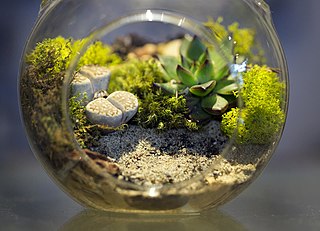
A vivarium is an area, usually enclosed, for keeping and raising animals or plants for observation or research. Water-based vivaria may have open tops providing they are not connected to other water bodies. An animal enclosure is considered a vivarium only if it provides quality of life through naturalistic components such as ample living space and natural decor that allow and encourage natural behaviours. Often, a portion of the ecosystem for a particular species is simulated on a smaller scale, with controls for environmental conditions such as temperature, humidity and light.
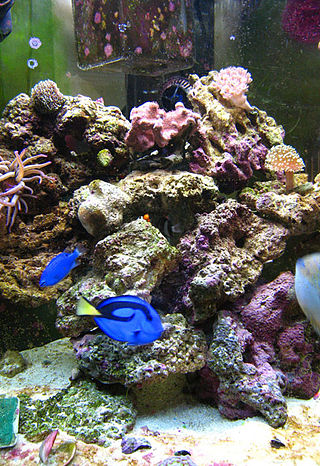
A marine aquarium is an aquarium that keeps marine plants and animals in a contained environment. Marine aquaria are further subdivided by hobbyists into fish only (FO), fish only with live rock (FOWLR), and reef aquaria. Fish only tanks often showcase large or aggressive marine fish species and generally rely on mechanical and chemical filtration. FOWLR and reef tanks use live rock, a material composed of coral skeletons harboring beneficial nitrogen waste metabolizing bacteria, as a means of more natural biological filtration.

Painted fish are ornamental aquarium fish which have been artificially coloured to appeal to consumers. This artificial colouring, also known as juicing, is achieved by a number of methods, such as injecting the fish with a hypodermic syringe containing bright fluorescent colour dye, dipping the fish into a dye solution, or feeding the fish dyed food.
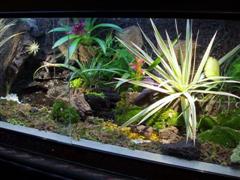
A paludarium is a type of vivarium that incorporates both terrestrial and aquatic elements. Paludaria usually consist of an enclosed container in which organisms specific to the biome being simulated are kept. They may be maintained for purely aesthetic reasons or for scientific or horticultural purposes. The word 'paludarium' comes from the Latin word 'palus' meaning marsh or swamp and '-arium' which refers to an enclosed container.
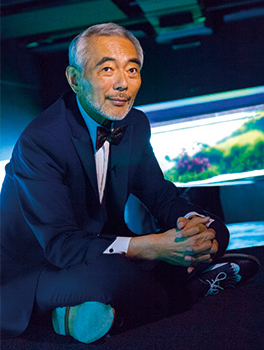
Takashi Amano was a professional track cyclist, photographer, designer, and aquarist. His interest in aquaria led him to create the Japanese company Aqua Design Amano.
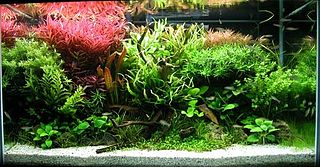
Aquascaping is the craft of arranging aquatic plants, as well as rocks, stones, cavework, or driftwood, in an aesthetically pleasing manner within an aquarium—in effect, gardening under water. Aquascape designs include a number of distinct styles, including the garden-like Dutch style and the Japanese-inspired nature style. Typically, an aquascape houses fish as well as plants, although it is possible to create an aquascape with plants only, or with rockwork or other hardscape and no plants.

Fishkeeping is a popular hobby, practiced by aquarists, concerned with keeping fish in a home aquarium or garden pond. There is also a piscicultural fishkeeping industry, serving as a branch of agriculture.
Practical Fishkeeping is a United Kingdom-based aquarium magazine. It is published every four weeks by Warners Publications Plc. The title covers the entire aquatic market from tropical freshwater and tropical marine fishkeeping throughout the year to small amounts of pond and coldwater fish coverage during the summer months.
Aquarium fish clubs or aquarium societies are social rather than academic associations for fishkeepers. They are to be found around the world. Some clubs include members in all the different aspects of the hobby, while others concentrate on one particular field, such as cichlids or marine fishkeeping. The first aquarium society ever formed was the Gotha Aquarium in Germany, founded in 1882. The oldest continuous aquarium club still in existence is the Boston Aquarium Society, founded in 1916. A Brooklyn Aquarium Society in New York City founded in 1911, but disbanded mid-century, and later reformed in the 1950s with the same name.

A freshwater aquarium is a receptacle that holds one or more freshwater aquatic organisms for decorative, pet-keeping, or research purposes. Modern aquariums are most often made from transparent glass or acrylic glass. Typical inhabitants include fish, plants, amphibians, and invertebrates, such as snails and crustaceans.
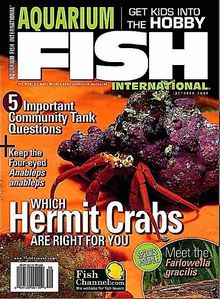
Aquarium Fish International (AFI) was a North American monthly magazine, published by BowTie Inc. of Irvine, California, and dedicated to freshwater and saltwater fishkeeping and the aquarium/fishkeeping hobby in general.

Aponogeton ulvaceus is a submerged aquatic plant in the Aponogetonaceae family. It has a small cone shaped, slightly hairy rhizome about 30 mm in diameter. The leaf blades have a base that tapers gradually, pale green in colour, over 50 cm (20 in) long and 8 cm (3 in) broad, with a wavy margin on petioles of an equal length, and in appearance slightly translucent. A single bulb may produce up to forty leaves in good conditions. No floating leaves are formed. The yellow flowers are produced on one or two, and sometimes more, erect spikes.

An aquarium is a vivarium of any size having at least one transparent side in which aquatic plants or animals are kept and displayed. Fishkeepers use aquaria to keep fish, invertebrates, amphibians, aquatic reptiles, such as turtles, and aquatic plants. The term aquarium, coined by English naturalist Philip Henry Gosse, combines the Latin root aqua, meaning 'water', with the suffix -arium, meaning 'a place for relating to'.

Hemianthus micranthemoides, also known as Micranthemum micranthemoides, pearl grass and pearl weed, is a popular aquatic plant most commonly used in aquascaping. It is very similar to H. callitrichoides, but has somewhat larger leaves. It belongs to the group of aquarium plants commonly known as "pearl weed".
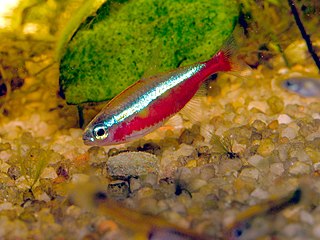
Project Piaba is a fishery initiative located on the Rio Negro tributary of the Amazon River. The program both promotes and researches sustainable aquarium pet fish collection and its impact on the environment. The name of the project comes from the Brazilian Portuguese word, piaba, which means "little fish", referring specifically to the cardinal tetra. Project Piaba is an ongoing project with annual research expeditions to the Rio Negro region. Because of the sustainable nature of the project, its slogan is "Buy a Fish, Save a Tree!"
Heiko Bleher is a German researcher, author, photographer, and filmmaker. He is best known in the scientific community for his contribution to the exploration of fresh and brackish water habitats worldwide. He has discovered numerous species of fish and aquatic plant, several of which carry his name or are named in honor of Bleher's family.

Feeder shrimp, ghost shrimp, glass shrimp, grass shrimp, river shrimp or feeder prawns are generic names applied to inexpensive small, typically with a length of 1 to 3 cm, semi-transparent crustaceans commonly sold and fed as live prey to larger more aggressive fishes kept in aquariums.
Cryptocoryne parva is an aquatic freshwater plant, often grown in aquariums. It is the smallest known member of the genus Cryptocoryne. Native to Sri Lanka, it grows as a small rosette reaching between 5 - 8 cm. Emersed leaves are a little wider than those growing under water. The spathe is c. 1.5 cm.
References
- 1 2 3 Vincent, Alice (21 January 2018). "Aquascaping: the addictive hobby that's making gardeners grow underwater". The Daily Telegraph . Retrieved 5 May 2021.
- 1 2 Perrone, Jane (10 May 2019). "Aquascaping: 'landscape gardening, but underwater'". Financial Times . Retrieved 5 May 2021.
- ↑ Blom, Hans Petter (3 November 2019). "Hager under vann". NRK (in Norwegian Bokmål). Retrieved 17 May 2021.
- ↑ Wace, Charlotte (1 May 2021). "Men lose themselves in the art of aquascaping". The Times . Retrieved 5 May 2021.
- ↑ "George Farmer - YouTube". www.youtube.com. Retrieved 11 January 2023.
- ↑ "About George". George Farmer Studios.